Genomic Baselines for Muskellunge in West Virginia: Implications for Stocking and Conservation
Abstract
1. Introduction
2. Materials and Methods
2.1. Sample Collection
2.2. Study Area
2.3. DNA Extraction, Library Preparation, and Sequencing
2.4. Processing of Generated ddRAD Sequences
2.5. Population Structuring and Genomic Diversity
3. Results
3.1. Dataset Generation
3.2. Population Structuring and Strain Identification
3.3. Genomic Diversity
4. Discussion
Supplementary Materials
Author Contributions
Funding
Institutional Review Board Statement
Informed Consent Statement
Data Availability Statement
Acknowledgments
Conflicts of Interest
References
- Kerr, S.J. Distribution and Management of Muskellunge in North America; Fisheries Policy Section; Ontario Ministry of Natural Resources: Peterborough, UK, 2011. [Google Scholar]
- White, M.M.; Kohli, B.A.; Converse, P.E. Historical and Contemporary Gene Flow and the Genetic Structure of Muskellunge in the Ohio River Drainage. Trans. Am. Fish. Soc. 2018, 147, 1067–1077. [Google Scholar] [CrossRef]
- Cincotta, D.A.; Welsh, S.A. An Update of the Ichthyofauna of West Virginia with Notes on Historic Sportfish Stockings. Northeast. Nat. 2024, 31, 1–48. [Google Scholar] [CrossRef]
- Hourston, A.S. A Study of Variations in the Maskinonge from Three Regions in Canada; Royal Ontario Museum: Toronto, ON, Canada, 1955. [Google Scholar]
- Crossman, E.J. Taxonomy and Distribution of North American Esocids. Am. Fish. Soc. Spec. Publ. 1978, 11, 13–26. [Google Scholar]
- Crossman, E.J. The Noble Muskellunge: A Review. In Managing Muskies: A Treatise on the Biology and Propagation of Muskellunge in North America; Special Publication; American Fisheries Society: Bethesda, MD, USA, 1986; pp. 1–13. [Google Scholar]
- Bieber, J.F.; Louison, M.J.; Suski, C.D. Capture Is Predicted by Behavior and Size, Not Metabolism, in Muskellunge. North Am. J. Fish. Manag. 2023, 43, 231–243. [Google Scholar] [CrossRef]
- Faust, M.D.; Isermann, D.A.; Luehring, M.A.; Hansen, M.J. Muskellunge Growth Potential in Northern Wisconsin: Implications for Trophy Management. N. Am. J. Fish. Manag. 2015, 35, 765–774. [Google Scholar] [CrossRef]
- Vinson, M.R.; Angradi, T.R. Muskie Lunacy: Does the Lunar Cycle Influence Angler Catch of Muskellunge (Esox Masquinongy)? PLoS ONE 2014, 9, e98046. [Google Scholar] [CrossRef] [PubMed]
- Schaeffer, E.M.; Pinkerton, J.J.; Venturelli, P.A.; Miller, L.M. Muskellunge Spatial Ecology in the St. Louis River Estuary and Southwestern Lake Superior. Trans. Am. Fish. Soc. 2020, 149, 651–663. [Google Scholar] [CrossRef]
- Kapuscinski, K.L.; Crane, D.P.; Gronda, T. Prey Selection and Time to Consumption Differ between Congeneric Muskellunge and Northern Pike. J. Great Lakes Res. 2022, 48, 1087–1092. [Google Scholar] [CrossRef]
- Kumar, G.; Kocour, M. Applications of Next-Generation Sequencing in Fisheries Research: A Review. Fish. Res. 2017, 186, 11–22. [Google Scholar] [CrossRef]
- Swain, P.P.; Sahoo, L.; Kumar, R.; Sundaray, J.K. Applications of Next-Generation Sequencing in Aquaculture and Fisheries. In Advances in Fisheries Biotechnology; Pandey, P.K., Parhi, J., Eds.; Springer Nature: Singapore, 2021; pp. 41–64. ISBN 978-981-16-3215-0. [Google Scholar]
- Li, Y.-H.; Wang, H.-P. Advances of Genotyping-by-Sequencing in Fisheries and Aquaculture. Rev Fish Biol Fish. 2017, 27, 535–559. [Google Scholar] [CrossRef]
- Reiss, H.; Hoarau, G.; Dickey-Collas, M.; Wolff, W.J. Genetic Population Structure of Marine Fish: Mismatch between Biological and Fisheries Management Units. Fish Fish. 2009, 10, 361–395. [Google Scholar] [CrossRef]
- Ovenden, J.R.; Berry, O.; Welch, D.J.; Buckworth, R.C.; Dichmont, C.M. Ocean’s Eleven: A Critical Evaluation of the Role of Population, Evolutionary and Molecular Genetics in the Management of Wild Fisheries. Fish Fish. 2015, 16, 125–159. [Google Scholar] [CrossRef]
- Johnson, A.; Zipfel, K.J.; Hallerman, E.M.; Massure, W.; Euclide, P.; Welsh, A.B. Genomic Evaluation of Native Walleye in the Appalachian Region and the Effects of Stocking. Trans. Am. Fish. Soc. 2023, 152, 346–360. [Google Scholar] [CrossRef]
- Euclide, P.T.; Larson, W.A.; Bootsma, M.; Miller, L.M.; Scribner, K.T.; Stott, W.; Wilson, C.C.; Latch, E.K. A New GTSeq Resource to Facilitate Multijurisdictional Research and Management of Walleye Sander Vitreus. Ecol. Evol. 2022, 12, e9591. [Google Scholar] [CrossRef]
- Chen, K.-Y.; Euclide, P.T.; Ludsin, S.A.; Larson, W.A.; Sovic, M.G.; Gibbs, H.L.; Marschall, E.A. RAD-Seq Refines Previous Estimates of Genetic Structure in Lake Erie Walleye. Trans. Am. Fish. Soc. 2020, 149, 159–173. [Google Scholar] [CrossRef]
- Kazyak, D.C.; Lubinski, B.A.; Rash, J.M.; Johnson, T.C.; King, T.L. Development of Genetic Baseline Information to Support the Conservation and Management of Wild Brook Trout in North Carolina. N. Am. J. Fish. Manag. 2021, 41, 626–638. [Google Scholar] [CrossRef]
- O’Leary, S.J.; Hice, L.A.; Feldheim, K.A.; Frisk, M.G.; McElroy, A.E.; Fast, M.D.; Chapman, D.D. Severe Inbreeding and Small Effective Number of Breeders in a Formerly Abundant Marine Fish. PLoS ONE 2013, 8, e66126. [Google Scholar] [CrossRef]
- Wilson, C.C.; Liskauskas, A.P.; Wozney, K.M. Pronounced Genetic Structure and Site Fidelity among Native Muskellunge Populations in Lake Huron and Georgian Bay. Trans. Am. Fish. Soc. 2016, 145, 1290–1302. [Google Scholar] [CrossRef]
- Chinchilla-Vargas, J.; Meerbeek, J.R.; Rothschild, M.F.; Bertolini, F. Signatures of Selection and Genomic Diversity of Muskellunge (Esox Masquinongy) from Two Populations in North America. Genes 2021, 12, 1021. [Google Scholar] [CrossRef]
- Rougemont, Q.; Carrier, A.; Le Luyer, J.; Ferchaud, A.-L.; Farrell, J.M.; Hatin, D.; Brodeur, P.; Bernatchez, L. Combining Population Genomics and Forward Simulations to Investigate Stocking Impacts: A Case Study of Muskellunge (Esox Masquinongy) from the St. Lawrence River Basin. Evol. Appl. 2019, 12, 902–922. [Google Scholar] [CrossRef]
- Scott, W.B.; Crossman, E.J. Freshwater Fishes of Canada. Fish. Res. Board Can. 1973, 184, 1–966. [Google Scholar]
- Poland, J.; Brown, P.; Sorrells, M.; Jannink, J.-L. Development of High-Density Genetic Maps for Barley and Wheat Using a Novel Two-Enzyme Genotyping-by-Sequencing Approach. PLoS ONE 2012, 7, e32253. [Google Scholar] [CrossRef] [PubMed]
- Martin, M. Cutadapt Removes Adapter Sequences from High-Throughput Sequencing Reads. EMBnet. J. 2011, 17, 10–12. [Google Scholar] [CrossRef]
- Catchen, J.; Hohenlohe, P.A.; Bassham, S.; Amores, A.; Cresko, W.A. Stacks: An Analysis Tool Set for Population Genomics. Mol. Ecol. 2013, 22, 3124–3140. [Google Scholar] [CrossRef]
- Langmead, B.; Salzberg, S.L. Fast Gapped-Read Alignment with Bowtie 2. Nat Methods 2012, 9, 357–359. [Google Scholar] [CrossRef]
- Li, H.; Handsaker, B.; Wysoker, A.; Fennell, T.; Ruan, J.; Homer, N.; Marth, G.; Abecasis, G.; Durbin, R. 1000 Genome Project Data Processing Subgroup The Sequence Alignment/Map Format and SAMtools. Bioinformatics 2009, 25, 2078–2079. [Google Scholar] [CrossRef]
- Rousset, F. Genepop’007: A Complete Re-Implementation of the Genepop Software for Windows and Linux. Mol. Ecol. Resour. 2008, 8, 103–106. [Google Scholar] [CrossRef]
- Purcell, S.; Neale, B.; Todd-Brown, K.; Thomas, L.; Ferreira, M.A.R.; Bender, D.; Maller, J.; Sklar, P.; de Bakker, P.I.W.; Daly, M.J.; et al. PLINK: A Tool Set for Whole-Genome Association and Population-Based Linkage Analyses. Am. J. Hum. Genet. 2007, 81, 559–575. [Google Scholar] [CrossRef]
- de Jong, M.J.; de Jong, J.F.; Hoelzel, A.R.; Janke, A. SambaR: An R Package for Fast, Easy and Reproducible Population-Genetic Analyses of Biallelic SNP Data Sets. Mol. Ecol. Resour. 2021, 21, 1369–1379. [Google Scholar] [CrossRef]
- Wickham, H. Ggplot2. WIREs Comput. Stat. 2011, 3, 180–185. [Google Scholar] [CrossRef]
- Jombart, T. Adegenet: A R Package for the Multivariate Analysis of Genetic Markers. Bioinformatics 2008, 24, 1403–1405. [Google Scholar] [CrossRef] [PubMed]
- Alexander, D.H.; Lange, K. Enhancements to the ADMIXTURE Algorithm for Individual Ancestry Estimation. BMC Bioinform. 2011, 12, 246. [Google Scholar] [CrossRef] [PubMed]
- Gruber, B.; Unmack, P.J.; Berry, O.F.; Georges, A. Dartr: An r Package to Facilitate Analysis of SNP Data Generated from Reduced Representation Genome Sequencing. Mol. Ecol. Resour. 2018, 18, 691–699. [Google Scholar] [CrossRef]
- Benjamini, Y.; Hochberg, Y. Controlling the False Discovery Rate: A Practical and Powerful Approach to Multiple Testing. J. R. Stat. Soc. Ser. B (Methodol.) 1995, 57, 289–300. [Google Scholar] [CrossRef]
- Watterson, G.A. On the Number of Segregating Sites in Genetical Models without Recombination. Theor. Popul. Biol. 1975, 7, 256–276. [Google Scholar] [CrossRef]
- Tajima, F. Statistical Method for Testing the Neutral Mutation Hypothesis by DNA Polymorphism. Genetics 1989, 123, 585–595. [Google Scholar] [CrossRef]
- Whitlock, M.C.; Lotterhos, K.E. Reliable Detection of Loci Responsible for Local Adaptation: Inference of a Null Model through Trimming the Distribution of FST. Am. Nat. 2015, 186, S24–S36. [Google Scholar] [CrossRef]
- Luu, K.; Bazin, E.; Blum, M.G.B. Pcadapt: An R Package to Perform Genome Scans for Selection Based on Principal Component Analysis. Mol. Ecol. Resour. 2017, 17, 67–77. [Google Scholar] [CrossRef]
- Do, C.; Waples, R.S.; Peel, D.; Macbeth, G.M.; Tillett, B.J.; Ovenden, J.R. NeEstimator v2: Re-Implementation of Software for the Estimation of Contemporary Effective Population Size (Ne) from Genetic Data. Mol. Ecol. Resour. 2014, 14, 209–214. [Google Scholar] [CrossRef]
- Sunde, J.; Yıldırım, Y.; Tibblin, P.; Forsman, A. Comparing the Performance of Microsatellites and RADseq in Population Genetic Studies: Analysis of Data for Pike (Esox Lucius) and a Synthesis of Previous Studies. Front. Genet. 2020, 11, 218. [Google Scholar] [CrossRef]
- Zimmerman, S.J.; Aldridge, C.L.; Oyler-McCance, S.J. An Empirical Comparison of Population Genetic Analyses Using Microsatellite and SNP Data for a Species of Conservation Concern. BMC Genom. 2020, 21, 382. [Google Scholar] [CrossRef] [PubMed]
- Johnson, A.; Zipfel, K.; Welsh, A. Advancing Conservation Strategies for Native Eastern Highlands-Strain Walleye Sander Vitreus in West Virginia: Insights from Genomic Investigations and Broodstock Screening. Diversity 2024, 16, 371. [Google Scholar] [CrossRef]
- Wahl, D.H. An Ecological Context for Evaluating the Factors Influencing Muskellunge Stocking Success. N. Am. J. Fish. Manag. 1999, 19, 238–248. [Google Scholar] [CrossRef]
- Meerbeek, J.R. Poststocking Behavior and Survival of Large Yearling Muskellunge (Esox Masquinongy) in Two Northern Iowa Natural Lakes. Fishes 2024, 9, 216. [Google Scholar] [CrossRef]
- Miller, L.M.; Mero, S.W.; Younk, J.A. The Impact of Stocking on the Current Ancestry in Twenty Native and Introduced Muskellunge Populations in Minnesota. Trans. Am. Fish. Soc. 2012, 141, 1411–1423. [Google Scholar] [CrossRef]
- Miller, L.M.; Mero, S.W.; Younk, J.A. The Genetic Legacy of Stocking Muskellunge in a Northern Minnesota Lake. Trans. Am. Fish. Soc. 2009, 138, 602–615. [Google Scholar] [CrossRef]
- Page, K.S.; Zweifel, R.D.; Stott, W. Spatial and Temporal Genetic Analysis of Walleyes in the Ohio River. Trans. Am. Fish. Soc. 2017, 146, 1168–1185. [Google Scholar] [CrossRef]
- Guinand, B.; Page, K.S.; Burnham-Curtis, M.K.; Scribner, K.T. Genetic Signatures of Historical Bottlenecks in Sympatric Lake Trout (Salvelinus Namaycush) Morphotypes in Lake Superior. Env. Biol Fish 2012, 95, 323–334. [Google Scholar] [CrossRef]
- Almodóvar, A.; Leal, S.; Nicola, G.G.; Hórreo, J.L.; García-Vázquez, E.; Elvira, B. Long-Term Stocking Practices Threaten the Original Genetic Diversity of the Southernmost European Populations of Atlantic Salmon Salmo Salar. Endanger. Species Res. 2020, 41, 303–317. [Google Scholar] [CrossRef]
- Schmidt, T.L.; Jasper, M.-E.; Weeks, A.R.; Hoffmann, A.A. Unbiased Population Heterozygosity Estimates from Genome-Wide Sequence Data. Methods Ecol. Evol. 2021, 12, 1888–1898. [Google Scholar] [CrossRef]
- Marandel, F.; Charrier, G.; Lamy, J.-B.; Le Cam, S.; Lorance, P.; Trenkel, V.M. Estimating Effective Population Size Using RADseq: Effects of SNP Selection and Sample Size. Ecol. Evol. 2020, 10, 1929–1937. [Google Scholar] [CrossRef] [PubMed]
- Kapuscinski, K.L.; Sloss, B.L.; Farrell, J.M. Genetic Population Structure of Muskellunge in the Great Lakes. Trans. Am. Fish. Soc. 2013, 142, 1075–1089. [Google Scholar] [CrossRef]
- Weller, J.D.; Leblanc, J.P.; Liskauskas, A.; Chow-Fraser, P. Spawning Season Distribution in Subpopulations of Muskellunge in Georgian Bay, Lake Huron. Trans. Am. Fish. Soc. 2016, 145, 795–809. [Google Scholar] [CrossRef]
- Crossman, E.J. Displacement, and Home Range Movements of Muskellunge Determined by Ultrasonic Tracking. Env. Biol Fish 1977, 1, 145–158. [Google Scholar] [CrossRef]
- Diana, J.S.; Hanchin, P.; Popoff, N. Movement Patterns and Spawning Sites of Muskellunge Esox Masquinongy in the Antrim Chain of Lakes, Michigan. Env. Biol Fish 2015, 98, 833–844. [Google Scholar] [CrossRef]
- Henesy, J.; Goetz, D.; Mullican, J.E. Seasonal Movement Patterns and Summertime Use of Thermal Refuge Areas by Muskellunge in the Nontidal Potomac River, Maryland. North Am. J. Fish. Manag. 2022, 42, 1144–1154. [Google Scholar] [CrossRef]
- Morrison, S.; Warren, L. Seasonal Movements of Muskellunge in North Bend Lake, West Virginia. J. Southeast. Assoc. Fish Wildl. Agencies 2015, 2, 42–49. [Google Scholar]
- Palmer, G.; Williams, J.; Scott, M.; Finne, K.; Johnson, N.; Dutton, D.; Murphy, B.; Hallerman, E.M. Genetic Marker-Assisted Restoration of the Presumptive Native Walleye Fishery in the New River, Virginia and West Virginia. Proc. Annu. Conf. Southeast. Assoc. Fish Wildl. Agencies 2007, 61, 17–22. [Google Scholar]
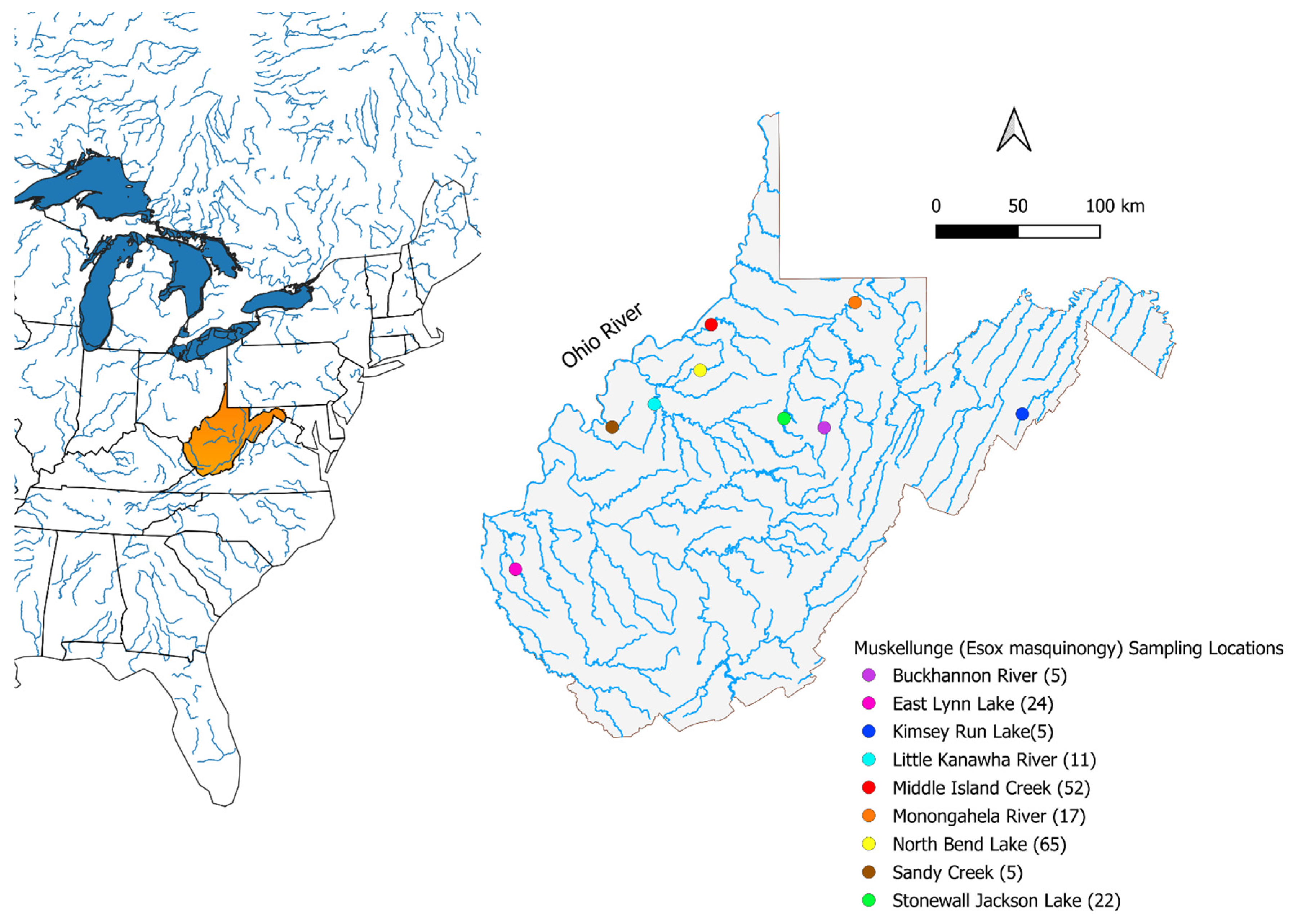

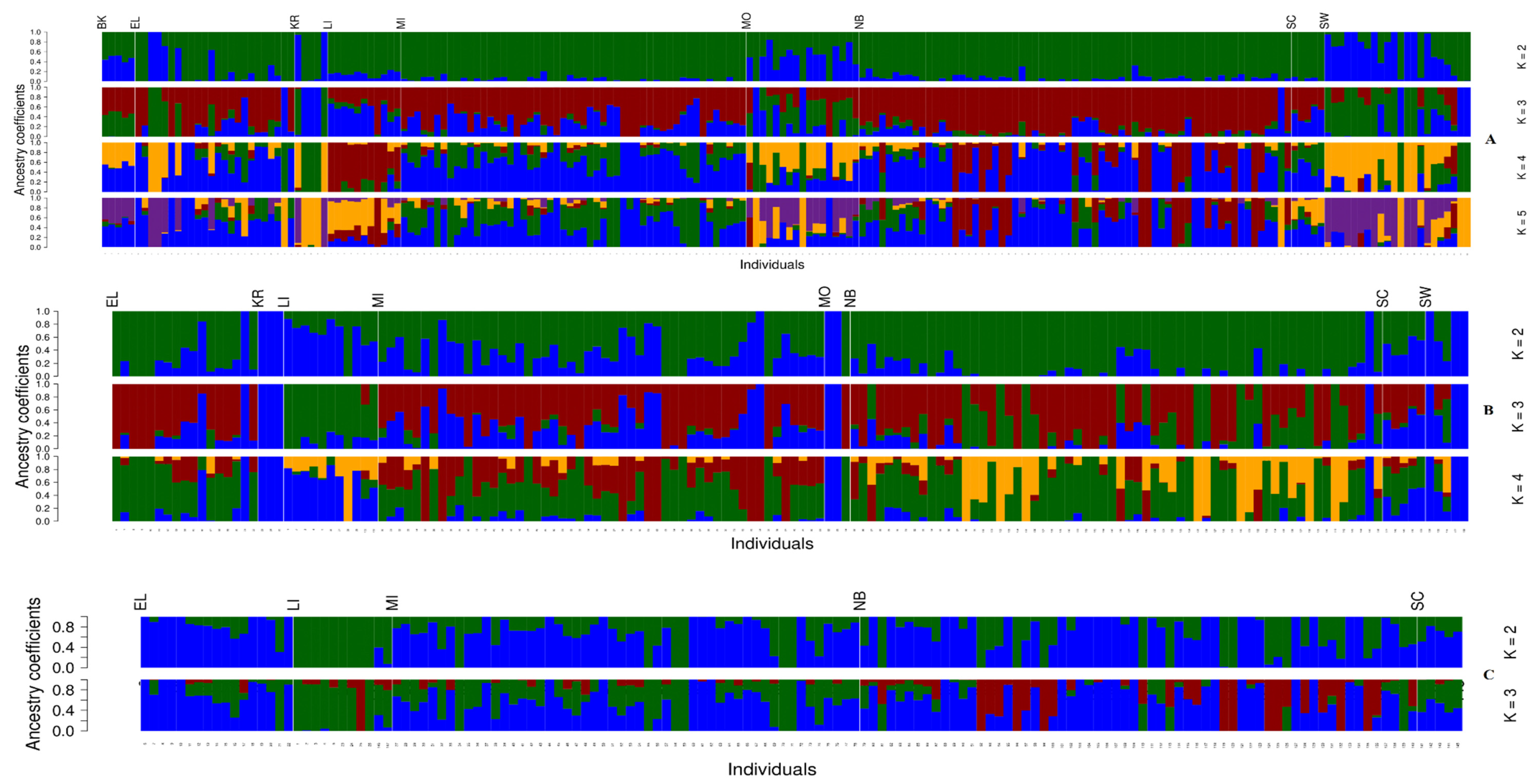
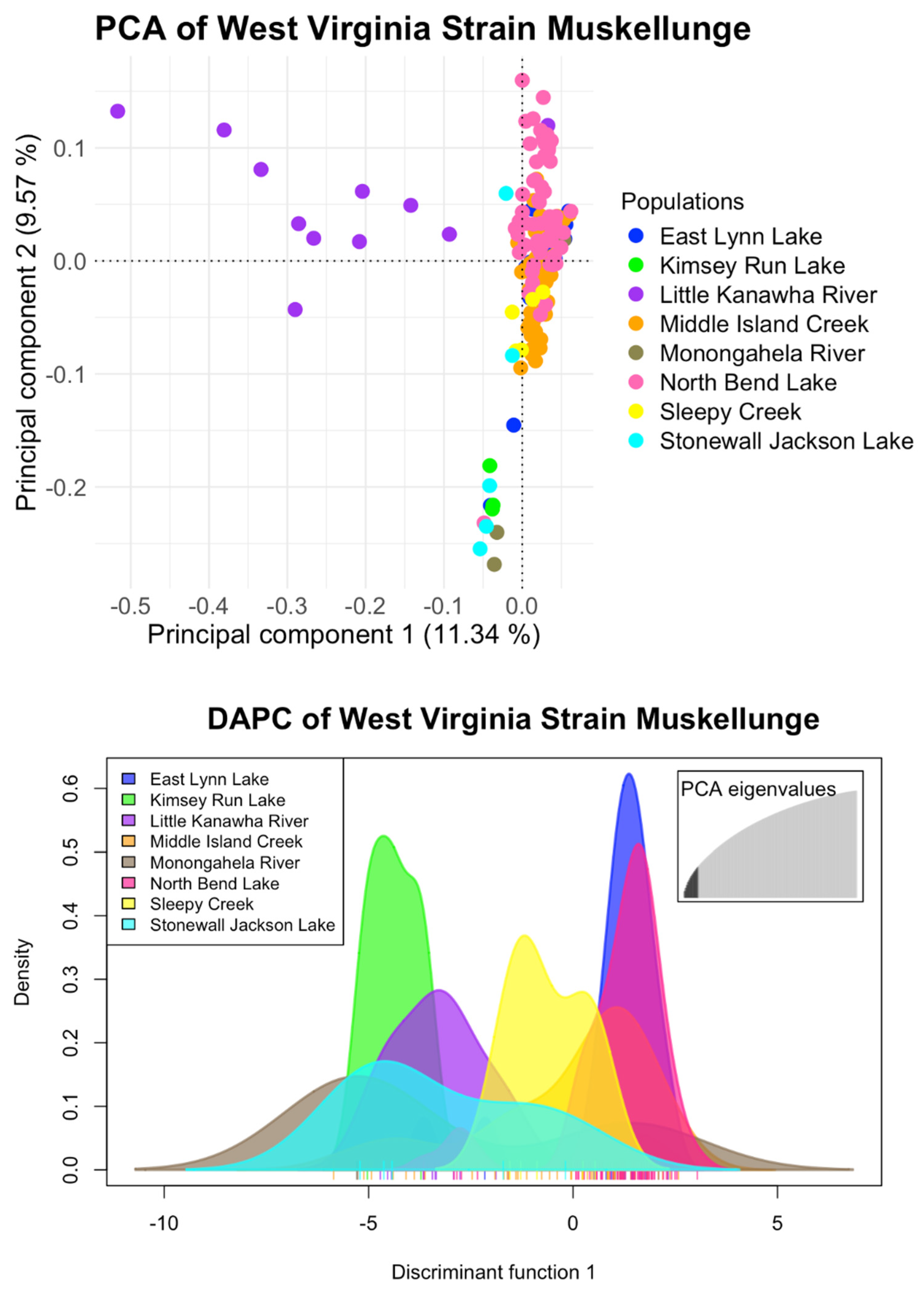
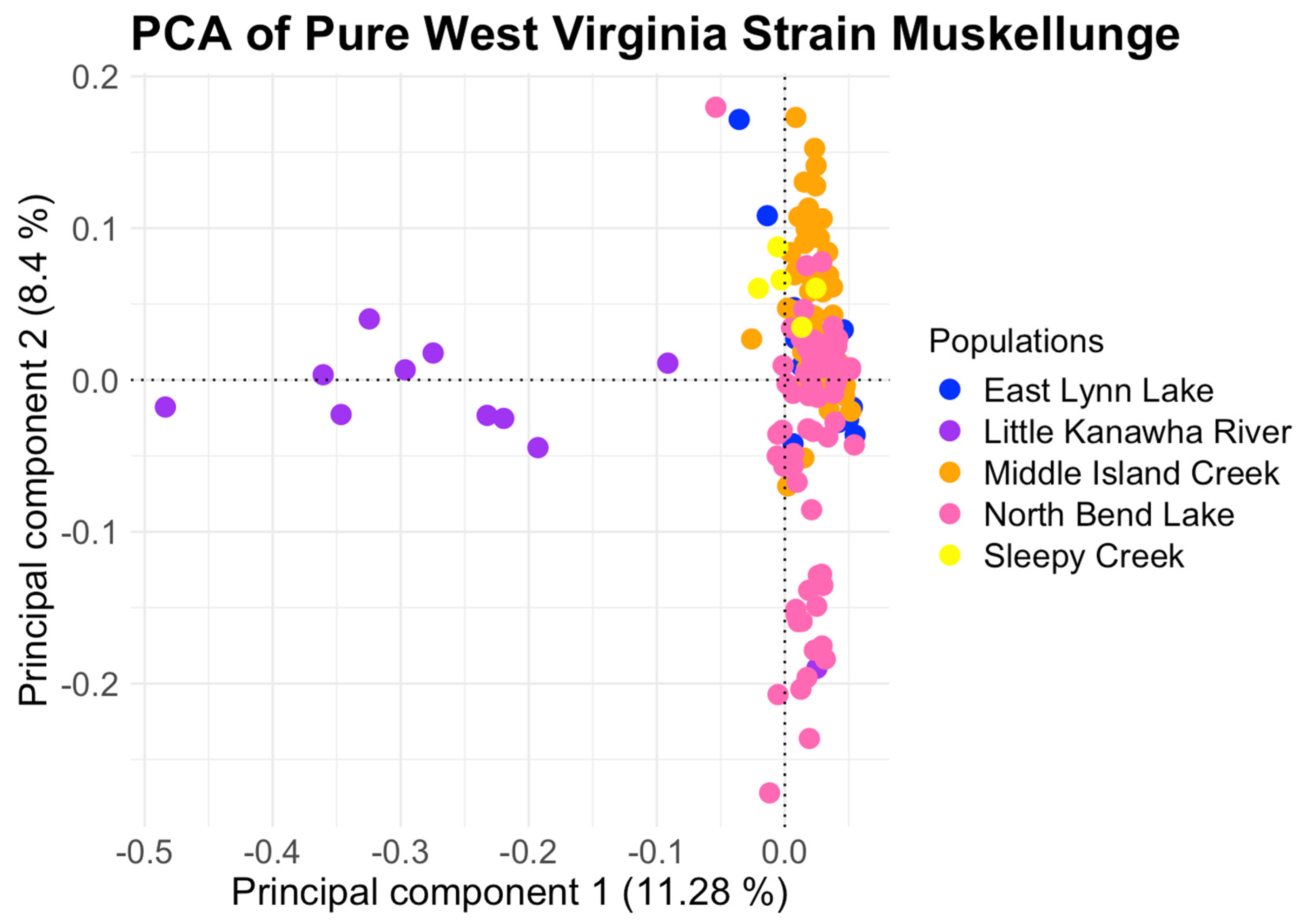
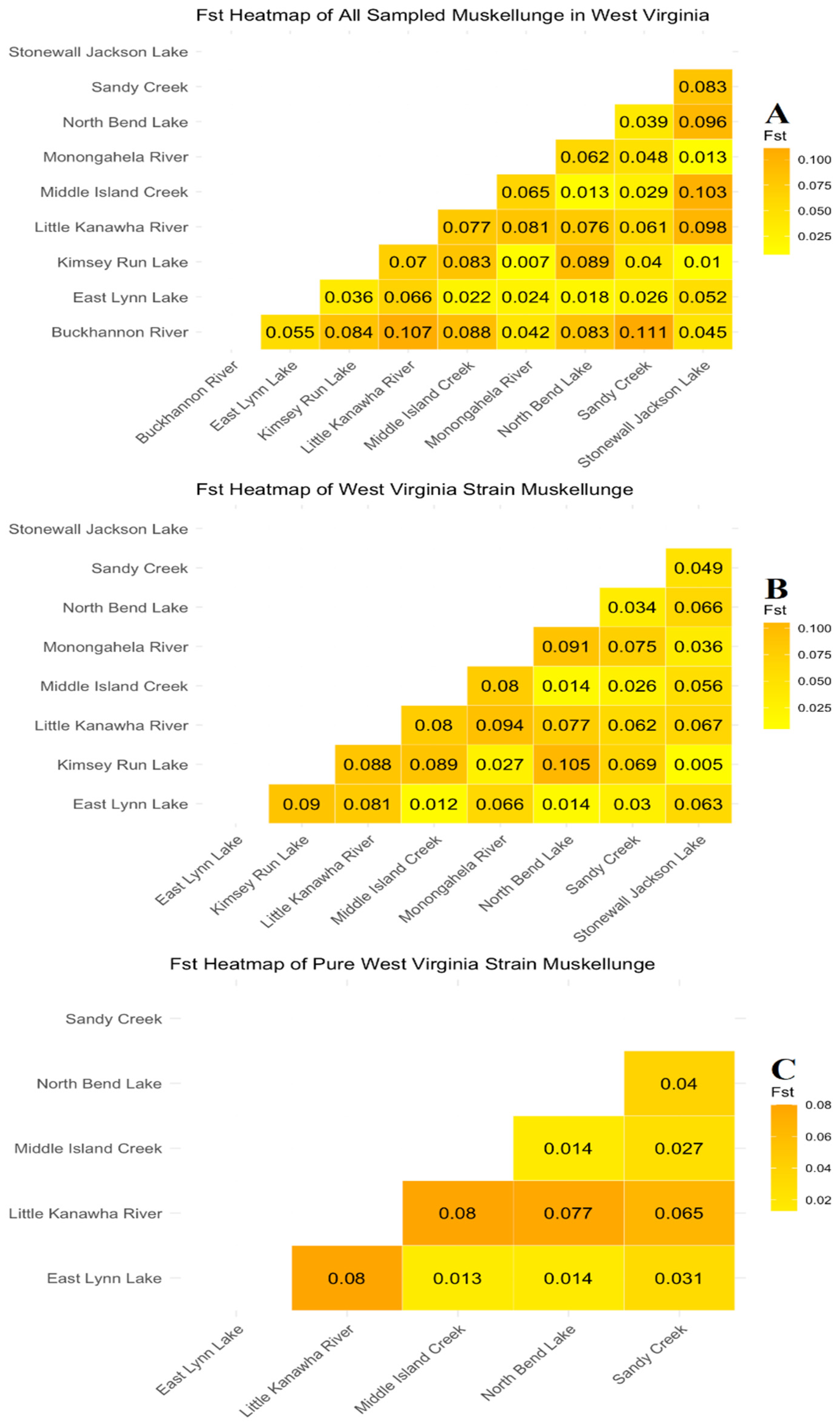
| Locus | Scaffold/Accession | BP | West Virginia | New York |
|---|---|---|---|---|
| 871013 | JACXGI010036579.1 | 3233 | GCACACGCGCACAC | GCACACGCACACAC |
| 735725 | JACXGI010016854.1 | 8685 | GTCCTTTCTGAGCAGG | GTCCTTTCTGCGCAGG |
| 507110 | JACXGI010007232.1 | 10,652 | GGGGGAATTCAAACTC | GGGGGAATTCGAACTC |
| 540715 | JACXGI010008188.1 | 245 | AATGTCGGCATGTGTT | AATGTCGGCGTGTGTT |
| 582779 | JACXGI010009543.1 | 1068 | CAGTCACGCCTCAGTT | CAGTCACGCCCCAGTT |
| 747854 | JACXGI010017737.1 | 4800 | ACAGACACTCCTGCTC | ACAGACACTGCTGCTC |
| 439545 | JACXGI010005572.1 | 17,457 | TATTGCCCATTTGATAG | TATTGCCCATTCGATAG |
| 70328 | JACXGI010000404.1 | 116,957 | CATCTGTGGCGAGACC | CATCTGTGGGGAGACC |
| 393496 | JACXGI010004619.1 | 7201 | GACATTTCATTGCAGA | GACATTTCAGTGCAGA |
| 557283 | JACXGI010008711.1 | 3345 | GGCTGCTTTGGAAAC | GGCTGCTTTTGAAAC |
| Population | P | P loci | Private | Π (SE) | HO (SE) | HE (SE) | HWE | FIS (SE) | Ɵ | Tajima | Ne (95% CI) |
|---|---|---|---|---|---|---|---|---|---|---|---|
| Buckhannon River (5) | 0.900 | 0.129 | 2 | 0.153 (0.004) | 0.155 (0.004) | 0.137 (0.003) | 11 (0.35%) | −0.003 (0.004) | 0.154 | −0.002 | ∞ |
| East Lynn Lake (24) | 0.900 | 0.226 | 5 | 0.152 (0.003) | 0.128 (0.003) | 0.148 (0.003) | 310 (9.85%) | 0.098 (0.022) | 0.185 | −0.036 | 16.1 (15.9–16.2) |
| Kimsey Run Lake (5) | 0.900 | 0.143 | 0 | 0.157 (0.003) | 0.128 (0.003) | 0.140 (0.003) | 38 (1.20%) | 0.066 (0.008) | 0.185 | −0.038 | ∞ |
| Little Kanawha River (11) | 0.894 | 0.171 | 47 | 0.159 (0.003) | 0.103 (0.003) | 0.151 (0.003) | 267 (8.48%) | 0.172 (0.014) | 0.188 | −0.038 | 93.5 (83.6–105.8) |
| Middle Island Creek (52) | 0.903 | 0.240 | 22 | 0.143 (0.003) | 0.129 (0.003) | 0.142 (0.003) | 390 (12.39%) | 0.082 (0.038) | 0.165 | −0.024 | 132.7 (72.7–79.6) |
| Monongahela River (17) | 0.892 | 0.214 | 7 | 0.163 (0.003) | 0.142 (0.003) | 0.158 (0.003) | 228 (7.24%) | 0.078 (0.017) | 0.194 | −0.034 | 72.3 (69.6–75.2) |
| North Bend Lake (65) | 0.902 | 0.247 | 33 | 0.145 (0.003) | 0.138 (0.004) | 0.144 (0.003) | 347 (11.02%) | 0.052 (0.050) | 0.162 | −0.019 | 61.6 (61.2–62.1) |
| Sandy Creek (5) | 0.916 | 0.114 | 0 | 0.132 (0.003) | 0.112 (0.003) | 0.117 (0.003) | 19 (0.60%) | 0.044 (0.009) | 0.153 | −0.029 | ∞ |
| Stonewall Jackson Lake (22) | 0.883 | 0.235 | 10 | 0.174 (0.003) | 0.167 (0.003) | 0.170 (0.003) | 154 (4.89%) | 0.033 (0.017) | 0.185 | −0.014 | 20.1 (19.9–20.3) |
| Population | P | P loci | Private | Π (SE) | HO (SE) | HE (SE) | HWE | FIS (SE) | Ɵ | Tajima | Ne (95% CI) |
|---|---|---|---|---|---|---|---|---|---|---|---|
| East Lynn Lake (17) | 0.888 | 0.085 | 2 | 0.167 (0.003) | 0.147 (0.003) | 0.162 (0.003) | 249 (8.08%) | 0.080 (0.018) | 0.196 | −0.033 | 32.6 (32.0–33.3) |
| Little Kanawha River (11) | 0.869 | 0.080 | 74 | 0.194 (0.003) | 0.124 (0.003) | 0.184 (0.003) | 303 (9.83%) | 0.207 (0.014) | 0.224 | −0.040 | 67.9 (63.1–73.4) |
| Middle Island Creek (52) | 0.880 | 0.110 | 51 | 0.177 (0.003) | 0.158 (0.003) | 0.175 (0.003) | 489 (15.86%) | 0.102 (0.041) | 0.194 | −0.019 | 120.6 (119.0–122.3) |
| North Bend Lake (62) | 0.879 | 0.113 | 78 | 0.179 (0.003) | 0.172 (0.003) | 0.177 (0.003) | 411 (13.33%) | 0.060 (0.051) | 0.191 | −0.015 | 58.0 (57.6–58.4) |
| Sandy Creek (5) | 0.894 | 0.055 | 0 | 0.163 (0.004) | 0.139 (0.004) | 0.145 (0.003) | 24 (0.78%) | 0.054 (0.009) | 0.188 | −0.034 | ∞ |
Disclaimer/Publisher’s Note: The statements, opinions and data contained in all publications are solely those of the individual author(s) and contributor(s) and not of MDPI and/or the editor(s). MDPI and/or the editor(s) disclaim responsibility for any injury to people or property resulting from any ideas, methods, instructions or products referred to in the content. |
© 2025 by the authors. Licensee MDPI, Basel, Switzerland. This article is an open access article distributed under the terms and conditions of the Creative Commons Attribution (CC BY) license (https://creativecommons.org/licenses/by/4.0/).
Share and Cite
Johnson, A.; Taylor, N.; Welsh, A. Genomic Baselines for Muskellunge in West Virginia: Implications for Stocking and Conservation. Hydrobiology 2025, 4, 7. https://doi.org/10.3390/hydrobiology4010007
Johnson A, Taylor N, Welsh A. Genomic Baselines for Muskellunge in West Virginia: Implications for Stocking and Conservation. Hydrobiology. 2025; 4(1):7. https://doi.org/10.3390/hydrobiology4010007
Chicago/Turabian StyleJohnson, Andrew, Nate Taylor, and Amy Welsh. 2025. "Genomic Baselines for Muskellunge in West Virginia: Implications for Stocking and Conservation" Hydrobiology 4, no. 1: 7. https://doi.org/10.3390/hydrobiology4010007
APA StyleJohnson, A., Taylor, N., & Welsh, A. (2025). Genomic Baselines for Muskellunge in West Virginia: Implications for Stocking and Conservation. Hydrobiology, 4(1), 7. https://doi.org/10.3390/hydrobiology4010007






